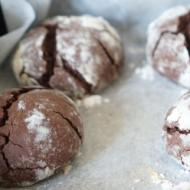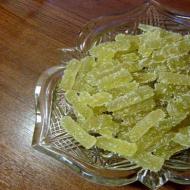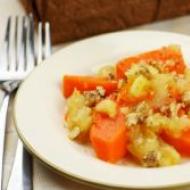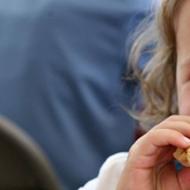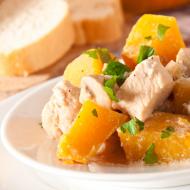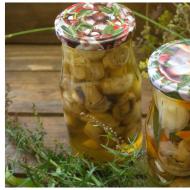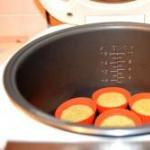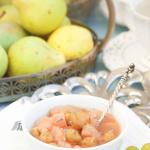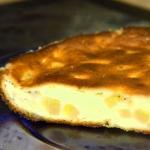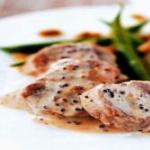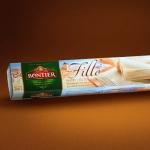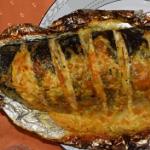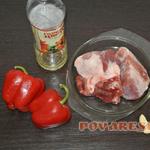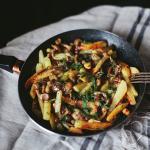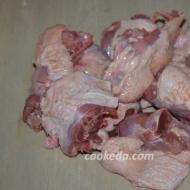
Gingerbread making technology. Preparation and recipe for gingerbread dough products Industrial preparation of gingerbread dough recipe
Technological schemes for the production of gingerbread (custard and raw)
Gingerbreads are flour confectionery products of various shapes with a convex surface, containing a large amount of sugar and various flavoring additives.
Gingerbreads are a baked semi-finished gingerbread dough product layered, most often with fruit filling or jam, and having a rectangular flat shape.
Depending on the technology for preparing the dough, gingerbreads are divided into custard and raw. Each of these products can be produced with or without filling, glazed or unglazed.
The technological process for preparing gingerbread (Fig. 1.2.) consists of the following operations:
preparation of raw materials for production;
dough preparation;
molding;
cooling;
glazing (for glazed gingerbread);
packaging, labeling, transportation and storage.
Preparation of raw materials for production
Preparation of raw materials for production is carried out in accordance with the current documents: “Instructions for preventing the ingress of foreign objects into products at enterprises of the confectionery industry and in cooperatives” (Appendix 1), “Sanitary rules and regulations SanPiN 2.3.4.545-96.
Rice. 1.2. Technological scheme for the production of gingerbread
Production of bread, bakery and confectionery products (Appendix 2), issued to replace the “Sanitary rules for enterprises of the confectionery industry (except for enterprises producing cream confectionery products)” and “Sanitary rules for enterprises and workshops producing confectionery products with cream”.
Melange. Before being put into production, frozen melange is first thawed in water baths or special chambers at a temperature not exceeding 450C and filtered through a sieve with a mesh size of no more than 3 mm. For products in which whole milk or water is used when kneading the dough, the melange can be mixed in a 1:1 ratio before filtering. Thawed egg products should be used within 1 - 4 hours.
It is recommended to use egg powder in production in the form of a pre-prepared mixture with water. The humidity of this mixture should be 25 - 30%, the water temperature should not exceed 500C. The mixture must be filtered through a sieve with a mesh size of no more than 3 mm.
Milk. It is recommended to store whole milk in a specially equipped refrigerator. The milk cooling temperature is set depending on the duration of its storage. When stored for 6 - 12 hours, milk is cooled to a temperature of 8 - 100C, and when stored for 24 - 36 hours - to 4 - 50C. During milk storage, the laboratory must monitor its acidity.
Increased acidity (up to 400T) can be reduced to 180T by methods approved by sanitary authorities.
To reduce acidity, an aqueous 8.5% solution of baking soda (sodium bicarbonate) is used. Powdered whole or skim milk, if necessary, is first dissolved in a small amount of water used for preparing the dough.
Water for dissolving milk powder obtained in a spray dryer should have a temperature of 20 - 350C, in a drum dryer - 80 - 850C. If powdered milk is used to prepare sugar and milk syrups, it is mixed with water so that the mixture contains 60% water.
Before submitting for production, milk is filtered through a sieve with cells no larger than 2 mm.
High-viscosity condensed milk is heated to a temperature of 30 - 400C.
Nuts are used in whole, crushed and crushed form both when kneading dough and when finishing the surface of products. To improve the aroma and taste of nuts, they are fried at a temperature of 120 - 1400C to a humidity of 2 - 3%. The shells of nut kernels are removed as follows: hazelnut and peanut kernels are placed in a hot oven for several minutes; almond kernels are placed in boiling water for 1 minute, then washed with cold water and immediately dried at a temperature of 50 - 700C; Pistachio kernels are placed in boiling water for 30 s, then also washed and dried.
When processing kernels with hot water at a temperature of 70 - 800C, they are kept in water for 10 - 15 minutes.
Before grinding, spices are freed from foreign impurities, and some from their shells. After grinding, the spices are sifted through a sieve with cells with a diameter of no more than 2.5 mm.
Leavening agents and salt. Before being supplied to production, sodium bicarbonate, ammonium carbonate salts and table salt are sifted through a sieve with cells with a diameter of no more than 2 mm, and in dissolved form they are filtered through a sieve with a diameter of 0.5 mm.
To dissolve the specified raw materials, the following ratio is adopted: per 100 parts of water, 35 parts of table salt, 25 parts of ammonium carbonate salts, 10 parts of sodium bicarbonate.
Before use, pressed yeast is freed from paper; frozen yeast is slowly thawed at a temperature of 40C.
Fat from the refrigeration chamber is fed into the defrosting chamber and tempered to a temperature of about 200C.
The fat blocks, tempered and emptied from their containers, are loaded into an installation where fat plasticization is carried out. The melted fat is pumped into an intermediate tank, where it is stored at a temperature of 45 - 500C.
There must be continuous circulation of fat in the fat preparation system.
The malt extract is tempered to a temperature of 400C.
Citric acid, sodium pyrosulfite. Solutions of citric acid in a ratio of acid and water 1: 3 and sodium pyrosulfite (sodium metabisulfite) in a ratio of 1: 10 are prepared once or twice a shift in special containers. The water temperature for dissolving sodium pyrosulfite should be 15 - 200C, and for citric acid - no higher than 250C.
Water. The amount of water per batch is calculated using the following formula (1.1):
X = (100 * C/100 - A) - B(1.1)
where A is the desired moisture content of the dough;
B - all raw materials (without water) loaded into the kneader;
C is the weight of dry substances of this raw material, kg;
X is the required amount of water, l.
The above calculation establishes the approximate amount of water. The final dosage of water is determined by a test batch.
The production of gingerbread is one of the most profitable types of business, which can be undertaken even by a person who is not too knowledgeable in the intricacies of culinary art. Moreover, the prospects for the development of the gingerbread business are truly stunning. Thus, according to marketing research data from the STK Group company, the capacity of the domestic market alone has prospects for direct growth in consumption of about 3.7 thousand tons of finished products of various types of gingerbread and gingerbread similar to them, according to the market segment occupied and production technology. We should not forget about the possibilities of exporting products, which have been talked about a lot lately.
- Gingerbread technology
- Pros and cons of the business of preparing and selling gingerbread
- How much money do you need to invest and how much can you earn from making and selling gingerbread?
- Permit and OKVED code for a business selling gingerbread
- Step-by-step plan for opening a business for preparing and selling gingerbread cookies
- How to choose equipment for business
- What documents are needed for business
- Which tax system should I indicate?

Gingerbread technology
Gingerbread is a confectionery product, rectangular, round, oval or complex shaped, made from special gingerbread dough, with the addition of jam, spices, chopped berries, nuts, honey or candied fruits. As a rule, an inscription or a simple design is stamped on top of the gingerbread plate in various ways and a layer of confectionery glaze is applied.
The peculiarity of gingerbread dough in the finished product is its long shelf life, which is why this culinary sweet is popular as a souvenir.
It should also be noted that domestic gingerbread makers have good and glorious long-standing traditions, known abroad. So, in particular, family Tver gingerbread makers, back at the end of the 19th century, maintained their own company stores in major European capitals and made excellent money from it.
Pros and cons of the business of preparing and selling gingerbread
The most important, and in many ways, determining factor, is that this kind of production, of course, not on an industrial scale, can be located at home. At the same time, a very significant expense item, rent of premises, is crossed out
Gingerbread dough, unlike yeast dough, does not place increased demands on the quality of flour. This is also an extremely important factor. Since when preparing a number of the same bakery products, the indicators of gluten and IDC in the grain of the food group and the flour obtained from it are decisive. We are talking primarily about the possibility of using cheap 2nd grade flour
The finished product is stored for a very long time, which makes it possible to reduce the urgency of the issue of efficiency and speed of sales of the finished product and its reserves by several orders of magnitude.
A fairly simple technological cooking process, operations such as proofing and dough maturing do not require increased requirements for temperature and humidity conditions
The main components for production are available and do not require special conditions during transportation and storage
The most labor-intensive processes of kneading and shaping dough can be easily mechanized using available means

It is clear that the gingerbread business, like any other, has its pitfalls and negative sides:
High competition, and many players in the market have long-standing and proven production traditions. Entering the market and carving out your niche is not easy
One of the conditions for winning the sympathy of the consumer is the production of a high-quality product and exclusively from natural ingredients, which allows us to exclude large, but ordinary manufacturers who base their own recipes with various kinds of modifiers, essences and other ersatz products. It follows that your own recipe, based exclusively on natural products, will have an inflated cost and, as a result, reduced competitive potential
In the case of using exclusively manual labor for kneading and forming dough, the wage fund increases significantly, if we are talking about attracting hired workers to production, the maximum possible mechanization of manual labor places increased demands on the amount of initial capital
The production of food products causes certain difficulties in terms of compliance with sanitary and hygienic requirements, both for premises, transport, and personnel
How much money do you need to invest and how much can you earn from making and selling gingerbread?
Having weighed all the pros and cons of a purely organizational nature, we can begin to develop a disposition on the economic front.
We will make the calculation using the example of the “Tula anniversary gingerbread” recipe, which is distinguished by its technological simplicity and stable yield of the finished product.
2nd grade flour - 100 kg, /of which 0.75 kg for the dust of the molding table/
Granulated sugar, for dough and glaze - 35 kg
Molasses – 45 kg, /in the case of using natural honey, conversion factor 0.45/
Margarine – 2 kg
Vegetable oil – 0.55kg
Baking soda - 0.4 kg
Conditioned drinking water with moisture capacity – 26 l
Mixture of spices: ginger powder, cloves and crushed cinnamon – 0.04 kg
Output of finished products: 175 pcs.

Based on the fact that prices for the products and finished products specified in the recipe can vary significantly in the regions of the country, for an objective calculation you should substitute objective figures for your area, subtract the associated production and non-production costs and obtain cost and projected profit indicators.
Thus, on average in the Russian Federation, the average cost per kg of the finished product is 28.47 rubles, with the same average retail selling price being 62.74 rubles.
As general information, it should be added that for a small production with a finished product output of about 1000-1400 kg per month, the expected level of profitability should be in the range of 45-60% and should not be lower than 35%.
Permit and OKVED code for a business selling gingerbread
It should be recalled that the production of gingerbread and gingerbread is regulated by OKVED 10.72.32. and before production begins, it is necessary to obtain the necessary package of permits.

As a conclusion, I would like to note that starting with a small production of gingerbread, as an exclusively family business, an entrepreneur in a short time will be able to massively increase not only production volumes, but also the range of sweet baked goods. It is worth actively seeking opportunities to reduce costs by optimizing costs and, of course, looking for new markets, without stopping at already well-developed ones. Excellent safety of products, their excellent transportability and resistance to adverse factors open up very broad prospects for both qualitative and quantitative growth of your enterprise.
Step-by-step plan for opening a business for preparing and selling gingerbread cookies
Organizing a gingerbread business is not much different from other activities related to baking confectionery products. The entrepreneur's action plan includes:
- Registration of activities with the tax service, obtaining permits.
- Rent of premises and its arrangement in accordance with the standards of regulatory authorities.
- Purchase of equipment.
- Purchase raw materials.
- Find a sales market.
- Conduct advertising, create a website.
Conducting marketing research and drawing up a business plan will greatly simplify the work of a novice entrepreneur. Having an action plan in hand, starting the production of gingerbread is much easier.
How to choose equipment for business
For the automated process of preparing sweets, you will need to purchase special equipment:
- Dough kneading apparatus;
- Cauldron for cooking gingerbread;
- Apparatus for product design;
- Electric oven for baking products;
- Equipment for packing.
Equipment is purchased depending on production needs. In addition, it is necessary to buy furniture for arranging the warehouse, and special uniforms for the staff. To deliver gingerbreads you will need a car.
What documents are needed for business
The first thing you have to do is register an individual enterprise or LLC. Next, we need to get approval from the SES for the premises, approve the recipe and production plan. In addition, the entrepreneur must enter into agreements for garbage removal and disinfection of premises.
Which tax system should I indicate?
The optimal choice of taxation system for individual entrepreneurs is the simplified tax system with a rate of 6%, which is calculated from the income received. This system can also be used when registering a legal entity.
Gingerbread is a flour confectionery product of various shapes, containing a significant amount of sugary substances and mostly various spices. The gingerbread group also includes gingerbreads, which are baked semi-finished gingerbread dough products layered mainly with fruit filling or jam and having a rectangular flat shape. There are two main types of gingerbread: custard and raw. All types of gingerbread can be made with or without filling.
Gingerbread cookies are produced with various external finishes: glazing with sugar syrup with and without additives, chocolate glaze, sprinkled with sugar, poppy seeds, nut kernels.
Gingerbread was produced even before the use of beet sugar using honey. And currently, honey is widely used as one of the main types of raw materials. Many cities specialized in the production of certain varieties. This became the basis for the names of some types of gingerbread: “Tula”, “Vyazemsky”. Currently, large confectionery enterprises produce gingerbread on mechanized production lines. In Fig. Figure 1 shows a diagram of a line for the production of glazed custard gingerbread.
Rice. 1. Technological diagram for the production of gingerbread
Flour from container 1 is sifted in burat 2 and fed with a bucket 4 into hopper 5 of automatic scales 6. An auger 3 is used to transfer flour from the hopper to the scales. A weighed portion of flour for brewing is supplied to the kneading machine 7, into which hot sugar or sugar is supplied from the syrup tank. sugar-honey syrup. The resulting brew, after cooling, is mixed with other types of raw materials and flour. The dough on a trolley 8 is supplied to the molding machine 9. The molded dough pieces are sent to the oven 10, then to the cooling cabinet 11 and conveyor 12 is fed for further cooling onto the conveyor 13. The cooled gingerbreads are supplied to the glazing apparatus 15, into which pure sugar is supplied from tank 14. syrup. The syrup-coated gingerbreads enter the dryer 16 and onto the laying conveyor 17, where they are placed in containers.
The technology for producing raw gingerbread is simpler than custard gingerbread. During their production, the operation of making welding is eliminated. All raw materials provided for in the recipe, except flour, are loaded into a kneading machine and mixed. Then add flour and knead the dough. The operations of molding and baking are not fundamentally different from the same operations in the production of custard gingerbread. Many varieties of raw gingerbread are produced without glazing. After baking, they are cooled and immediately packed into containers.
The dough for raw gingerbread is prepared in kneading machines of various designs: drum kneaders with U-shaped blades mounted on a shaft, or universal kneaders with Z-shaped blades rotating towards one another.
All raw materials specified in the recipe are weighed and loaded into the kneading machine in the following sequence: sugar, water, honey, molasses, invert syrup, melange, essence, dry perfume, baking powder and, lastly, flour. If sugar is introduced in the form of sugar syrup prepared in advance, then the kneading process is carried out in two stages. First, load all the raw materials without flour and baking powder and mix for 1-2 minutes, and then after introducing baking powder and flour, mix for another 5-12 minutes.
The duration of the kneading is adjusted depending on the air temperature in the workshop, water temperature, rotation speed and capacity of the kneader. At elevated temperatures of air and water in the workshop, as well as with an increase in the rotation speed of the kneading elements, the duration of the kneading is reduced. With an increase in the capacity of the kneading machine and, accordingly, the mass of the load, the duration of the kneading is increased. Kneading is stopped when the mass becomes homogeneous with an even distribution of all raw materials. Disintegrants are administered in the form of an aqueous solution, which is prepared in advance. Semi-finished products, the preparation of which involves heating (sugar, sugar and invert syrup, burnt syrup), before being introduced into the kneading machine, are cooled to a temperature of no higher than 20° C. The water should also not have a temperature higher than 20° C. In all cases, the temperature of the finished dough is not should exceed 20-22° C, and humidity should be between 23.5-25.5%.
Elevated dough temperature leads to dough tightening, a process in which the gluten in flour interacts with water to give the dough its elastic properties. As a result, the shape of the products is disrupted.
When making dough for “Tula” and “Vyazemskie” gingerbread, first prepare sugar-honey syrup, then cool it to 30-35 ° C, knead all the raw materials, including flour, for 30-40 minutes. The final dough temperature should be 27-28° C, and its humidity should be 18-20%.
To increase the shelf life of raw gingerbread, invert syrup or artificial honey is used instead of sugar and 50% of wheat flour is replaced with rye flour. When kneading dough, flour is introduced before the rest of the raw materials and chemical leavening agents. The total kneading time is more than 1 hour, the dough moisture content is 15-16%.
The process of kneading dough for custard gingerbread is divided into three stages: brewing the flour, cooling the tea leaves and kneading the tea leaves with all the components.
The flour is brewed as follows. Sugary components are loaded into the digester: sugar, molasses, honey and water in the amount necessary to obtain a brew of a certain humidity (19-20%). The calculation is carried out according to formula (8-1), taking A equal to 20. When all the sugar has dissolved, the syrup is loaded into a kneading machine with a water jacket, cooled to a temperature of at least 68 ° C and gradually, while stirring, part of the flour intended for making tea leaves is added. After 10-15 minutes the brew is ready. It should not contain lumps or traces of unmixing. The brew is cooled in two ways. If the kneading machine has a water jacket and there is enough kneading capacity in the workshop, then cooling is carried out without unloading the brew from the machine, while cold water circulates in the water jacket. Another method is to unload the tea leaves from the kneading machine into special chests or boxes. The brew is unloaded in layers, the layer is sprinkled with crumbs or lubricated with vegetable oil and cooled in a room at an air temperature of 10-15 ° C. The first method has a number of advantages: cooling occurs much faster, there is no need to move the brew from the kneading machine into special containers and have a separate room for cooling. When cooling in boxes or chests, this takes a long time.
With proper and sufficient cooling of the brew, high quality of the finished product is ensured. Insufficiently cooled tea leaves result in dense, irregularly shaped gingerbread cookies. The cooled brew should have a temperature of 25-27° C. If cooling is carried out directly in the kneading machine, then already at 28-30° C the rest of the raw materials are introduced into the brew. In this case, the duration of the kneading is minimal and is only 10 minutes. When using tea leaves that have not been cooled in a kneading machine, the duration of the kneading is significantly increased, and depending on the speed of rotation of the kneading shaft, it is 30-60 minutes.
Gingerbread dough is formed on forming and depositing machines. Some types of gingerbread are molded using metal and wooden molds. Gingerbread cookies molded into wooden molds are called printed ones. These gingerbread cookies are mainly intended for children, so the shapes have the outlines of birds, fish and various animals. When forming such gingerbread cookies, the dough is pressed manually or using special wooden blocks into a wooden mold. The resulting dough piece is removed from the mold and placed on a metal sheet for baking.
When making gingerbread cookies with filling, some of the dough (about 50%) is rolled out into a layer with a rolling pin and spread with filling. A molded layer of dough removed from a wooden mold is placed on top of the filling. Without disturbing the pattern, both layers of dough are connected at the edges so that the filling is inside. The resulting puff pastry piece containing the filling inside is sent for baking. When molding some types of gingerbread, a blank consisting of two layers of rolled dough is placed in a wooden stencil mold, between which a layer of filling is previously placed. Wooden stencil forms are pre-lubricated with vegetable oil. This makes it easier to release the molded dough pieces from the molds. The dough for gingerbreads and loaves is formed by rolling into a layer. The thickness of the workpiece for gingerbreads is 11-13 mm, and for loaves 7-8 mm. The rolled out layer intended for loaves is cut into strips. The thickness of the dough pieces for custard gingerbread is maintained within the range of 8-11 mm, and for raw gingerbread - 10-13 mm.
Round-shaped gingerbread cookies are molded on a FAK-1 brand jigger. On this machine, in addition to gingerbread cookies, sugar cookies of various varieties and shapes can be molded. The jigging mechanism works as follows. The dough to be formed enters the hopper and falls into the gap between two rollers. One roll not only rotates, but also moves. As it moves, the gap between the rollers decreases, and the dough is pumped and pressed out through a flexible hose and a forming die. The matrix can move in a horizontal plane and at the same time give the workpiece a different configuration.
The FAK-1 depositor operates in different modes depending on the consistency of the dough. When forming the batter, it is deposited in individual doses. The rollers stop moving after approaching and pumping a dose of dough. When forming thick varieties, the dough comes out in the form of ropes. The cutting of the bundles into slices is carried out by a moving string.
Water of a certain temperature circulates in the jacket of the walls of the hopper and the matrices, which makes it possible to maintain a given temperature of the dough while molding it.
Gingerbread cookies are baked mainly in continuous conveyor ovens. Baking duration is 7-12 minutes at a temperature of about 200-240° C. “Mint” gingerbreads that are not glazed are baked at lower temperatures (190-210° C) in order to avoid the appearance of a dark color on their surface. “Tula” gingerbreads are baked at a higher temperature (265-270° C) for 5-6 minutes. The dough pieces pass through a humidification chamber before baking.
Gingerbreads and loaves are baked at a temperature of about 200 ° C (loaves for 12-15 minutes, gingerbreads for 25-40 minutes). When baking gingerbread, basically the same processes occur as when baking cookies. However, the significantly increased duration and relatively low baking temperatures of gingerbread cookies are associated with the increased thickness of the dough pieces used in their manufacture.
After baking, the gingerbreads are cooled for 20-22 minutes to 40-45° C. When baking on steel grids or belts, the gingerbreads are cooled without removing them directly from these surfaces. The gingerbreads are removed only when they are easily separated from the mesh or steel belt. When baking on stencil sheets, when leaving the oven, they are placed together with the products on shelves or fixed racks. After such pre-cooling, the products are easily removed and sent for final cooling. During the cooling process, the moisture content of the gingerbread cookies decreases significantly as the temperature drops.
Most varieties of gingerbread are processed. By finishing gingerbread we mean covering the surface with a layer of crystallized sugar. This operation is called glazing. As a result of this operation, the surface of the gingerbread is covered with a glossy, marble-like crust of crystallized sugar. Glazing is done as follows. Up to 20 kg of gingerbread are loaded into the pan and filled with sugar syrup at a temperature of 85-95°C. Gingerbreads are processed in a dragee pan for 1-2 minutes, then they are unloaded and dried at a temperature of about 60°C. In this case, the speed of movement of the cooling air should be close to 4 m/s. After drying the gingerbread for 9-10 minutes, they are additionally cooled by blowing air at the same speed, but at a temperature of 20-22°C. At mechanized enterprises, gingerbreads are glazed in continuous units. This unit is a drum rotating on a horizontal axis, into which gingerbread is continuously loaded and syrup is supplied. The duration of the process is reduced to 50-60 s. After cooling, the surface of the gingerbread becomes shiny from the sugar that has crystallized from the syrup. A layer of sugar helps maintain freshness and delays staling; in addition, after glazing, the taste of the gingerbread improves.
Gingerbread cookies are packed in corrugated cardboard, plywood or plank boxes. At the same time, small gingerbreads with a quantity of more than 30 pieces. 1 kg is packed in bulk, the rest are placed in boxes and crates. A certain amount of gingerbread is pre-packed in boxes.
Gingerbread is stored in well-ventilated, dry, clean warehouses that are not infested with barn pests. During storage, the temperature should not exceed 18°C, and the relative humidity should be 65-75%.
Under these conditions, the following storage periods are established for gingerbread cookies: for raw unglazed gingerbreads, except for mint ones, 20 days, like mint ones in the summer 10, and in winter 15 days, for raw glazed gingerbreads 30 days, for custard gingerbreads 45 days.


6.4.1. Preparing gingerbread dough
Characteristics of gingerbread dough. Gingerbread dough products come in a variety of shapes and contain large amounts of granulated sugar and various spices, which give them a special aroma. The mixture of spices added to the gingerbread dough is called “bouquet”, or “dry perfume”. It contains (%): cinnamon - 60, cloves - 12, allspice - 12, black pepper - 4, cardamom - 4, ginger - 8. In addition to gingerbread, gingerbread cookies are baked from gingerbread dough, sandwiched with fruit filling or jam.
Sometimes, instead of granulated sugar, artificial honey or invert syrup is added to the dough, and part of the wheat flour (50%) is replaced with rye flour. This improves the quality of gingerbread and reduces their shrinkage during long-term storage due to the increased hygroscopicity of these products.
The dough is loosened with chemical leavening agents, since the high content of granulated sugar and low humidity prevent the development of yeast.
To prepare gingerbread dough, take (g): flour - 1,000, granulated sugar - 300, water - 200, molasses - 100, honey - 100, eggs or melange - 100, butter or margarine - 100, ammonium carbonate - 8, salt - 4, dry spices - 4, granulated sugar for burning - 50.
Methods for preparing dough. The dough is prepared in two ways: raw and choux.
The dough prepared using the raw method has a loose and at the same time viscous consistency due to the high content of granulated sugar, honey and molasses. The products are placed in the bowl of the dough mixing machine in the following order: granulated sugar or sugar syrup, water, burnt sugar, honey, molasses or invert syrup, melange or eggs and mix everything well for 6... 10 minutes. Granulated sugar dissolves in the liquid and is evenly distributed in the mixture. The higher the temperature at which the dough is kneaded, the shorter the kneading time, otherwise the dough may become too long. After mixing the raw materials, finely ground spices, soda, ammonium dissolved in water, softened butter or margarine and flour are added to the bowl of the machine. The dough is kneaded for 10... 15 minutes, depending on the amount of dough and the temperature conditions of the room. The finished dough is a homogeneous mass of astringent, loose consistency; its temperature is not higher than 20 °C. At low humidity, gingerbread cookies turn out to be non-streamlined, and at high humidity, they become blurry and have poor lifting (Fig. 6.1).
The dough can be kneaded by hand. When making small portions of dough, the flour is sifted onto the table (6...8% of the flour is left for dusting), mixed with baking powder and shaped into a funnel, into which the prepared liquid is poured, after which softened butter is added. The flour and liquid are mixed towards the center. When some of the flour (approximately 50%) has combined with the liquid, quickly knead all the flour until the dough reaches a uniform consistency.
The process of preparing dough using the custard method consists of three stages: brewing flour in sugar-honey, sugar-honey or sugar-honey syrup; cooling the brew; mixing the tea leaves with all other types of raw materials provided for in the recipe.
The flour is brewed in an open digester. To do this, add granulated sugar and molasses, pour in water and, while mixing the products, heat the boiler to a temperature of 70... 75 °C until the granulated sugar is completely dissolved. The transparent syrup is filtered through a sieve into the bowl of a dough mixing machine, cooled to a temperature of at least 68 °C, sifted flour is gradually added and quickly mixed. If the syrup is cooled to a lower temperature, the quality of the gingerbread will deteriorate. When the flour is brewed, partial gelatinization of the starch occurs, so the gingerbread cookies stay fresh longer. Flour is mixed with hot syrup as quickly as possible (within 10... 12 minutes), since prolonged contact of unplaced flour with hot syrup may cause lumps to form (Fig. 6.2).
If the recipe calls for a lot of eggs and butter, then boil some of the flour, and use the remaining flour when kneading the dough, leaving 6...8% for dusting.
The choux pastry is cooled to 25...27 °C in chests or baking sheets, where the dough is placed in layers and greased with vegetable oil or sprinkled with crumbs so that a monolithic mass does not form. It is impossible to knead the dough without pre-cooling, as it loses its characteristic properties, the gingerbreads become dense, non-streamlined in shape, leavening agents and aromatic substances evaporate.
After cooling, the choux pastry is kneaded, combined with the rest of the products specified in the recipe, and kneaded until a homogeneous consistency is obtained for 30...40 minutes. The dough should be evenly mixed and have a creamy consistency. With shorter mixing times, products with a dense structure are obtained.
You can prepare the dough in a semi-brewed way. To do this, take 80% of the norm of water at a temperature of 70 °C, add granulated sugar, margarine and heat it to 90 °C, mix thoroughly, gradually adding 45% of the flour. The resulting mass is continued to be stirred for another 6...8 minutes, and then cooled to a temperature
25 °C. Honey, ammonium, soda are dissolved in the remaining water, combined with the cooled mass, eggs and the remaining flour are added. The dough is mixed for 10 minutes and cut.
Gingerbread cookies are dense if they were made from strong dough or if little leavening agent was added to the dough. Dough with a weak consistency, as well as at low baking temperatures, produces blurry products. Hard, rubbery products are obtained from dough with a low content of granulated sugar as a result of prolonged kneading or elevated dough temperature.
Shaping and baking the dough. The finished dough weighing 5...6 kg is laid out on a table heavily dusted with flour, kneaded and given an oblong shape. The layer is gradually rolled out with a smooth wooden rolling pin in different directions, periodically dusting with flour, to a thickness of 8... 10 mm. The layer must be rolled out evenly, otherwise the products will be of different thicknesses and bake unevenly. Before molding the products, test molding is carried out in different places of the formation to determine the uniformity of its rolling. The pattern is applied to the surface of the formation with a serrated or corrugated rolling pin. For molding products, various devices are used in the form of metal recesses, which are cone-shaped rims with pointed edges, the shape corresponding to the products being manufactured. Wooden forms with a design or inscription engraved on the board are used. If products need to be given a certain shape and a design applied to the surface, wooden forms are used in combination with metal recesses. Products are formed from a rolled out layer of dough using a knife, disk cutters or using notches.
Using a notch, press the dough layer 5-6 times, separating pieces of a certain shape from it, and lay them out in even rows on baking sheets. The recess is periodically immersed in flour, which prevents the dough from sticking to it. Before laying on the sheets, sweep the flour from the products with a brush. For gingerbreads and loaves, the dough is rolled out into a layer 12 and 8 mm thick, respectively. The layer must correspond to the size of the baking sheet. The loaves are cut with a knife or disk cutter into rectangular pieces of the appropriate size. After rolling out, the layer of dough for the gingerbread is placed on a sheet previously greased with vegetable oil or dusted with flour.
The surface of the product is moistened with cold water and pierced in several places with a knife to avoid swelling.
Piece products made from hard dough are placed on dry sheets, and from weak dough - on sheets dusted with flour or greased with oil. On products stuck to the sheet, voids form, and the bottoms turn out torn. If the products are greased with egg before baking, then in order to prevent them from moving during greasing, they are placed on sheets greased with a mixture of fat and warm water. Before baking, the surface of the products is sprinkled with granulated sugar, crumbs, chopped nuts or almonds, and decorated with raisins, candied fruits or nut kernels.
Gingerbread cookies are baked at a temperature of 200...240 °C for 10...15 minutes immediately after cutting, and gingerbread and mint gingerbread cookies are baked at a temperature of 190...210 °C. The baking mode and duration depend on the thickness of the products: the greater the thickness of the baked products, the lower the temperature and the longer the baking.
At high baking temperatures, a crust quickly forms, which prevents the removal of moisture from the crumb. After baking, the product will “sit” under the weight of the raw crumb. The low temperature in the oven makes the products blurry from excess granulated sugar. Timely formation of the crust preserves the shape of the gingerbread cookies.
After baking, the gingerbreads, greased with egg, are rubbed several times with a soft brush to obtain a better shine.
Gingerbread cookies can be glazed with sugar syrup. For this purpose, boilers with a capacity of 3...5 liters are used. Cooled products are poured with pre-prepared sugar syrup at a temperature of 85... 90 °C. The gingerbreads are mixed with the syrup using a wooden paddle for 1...2 minutes, and then unloaded onto sieves in one row and dried.
Below are the shortcomings of products that may arise when making gingerbread, and the reasons for their occurrence.
Disadvantages of products Products are dense, non-streamlined in shape
Products are blurry
Hard, rubbery products
The top crust is separated; raw crumb
Products have shrunk and fallen off
Products with empty bottoms Products have few pores
Causes of occurrence: Low humidity of the dough; the brew was not cooled sufficiently; a lot of sugary substances; little leavening agent Dough with high humidity; a lot of soda; poor gluten; low oven temperature Little granulated sugar; high temperature during mixing; long kneading Very soft dough; oven overheated
The dough is soft and has a lot of leavening agents; high oven temperature Dough is dense; The oven is not heated enough. There is not enough baking powder.
The dough prepared for gingerbread must be porous, well baked, without “hardening”; products must have the correct shape with a beautifully finished surface and a pronounced aroma.
6.4.2. Recipe for gingerbread dough products
Glazed gingerbread. The dough is prepared using the raw method, laid out on a table sprinkled with flour, and the products are shaped. The dough layer is rolled out to a thickness of 6 mm and gingerbread cookies are formed using a round notch. Bake the products on greased sheets at a temperature of 200 °C. After baking, the gingerbread cookies are glazed. To do this, 5...6 kg of gingerbread are loaded into a round cauldron, poured with hot (temperature 80...90°C) sugar syrup in the amount of 650...800 g and quickly mixed until their entire surface is covered with syrup . After this, the gingerbread cookies are laid out on nets and placed in special dryers under cooled ovens to dry.
Flour - 563, granulated sugar - 262, molasses - 57, melange (eggs) - 26, ammonium carbonate - 4, baking soda - 1.6, cloves - 7.3, water - 150, fat for lubricating sheets - 1, syrup for glazing - 120.
Exit - 1 000.
Honey gingerbread. The dough is prepared using the choux method. To do this, granulated sugar, water, and honey are loaded into the cauldron and boiled to a certain density. The density of the syrup is determined by taking a drop of syrup with your fingers and then spreading your fingers apart. There should be a thread. The finished syrup is filtered, fat is added to it and cooled to a temperature of 80...90°C. Add flour to the cooled syrup and knead the dough until smooth, without lumps. The dough is cooled to a temperature of 25...27 "C. The cooled dough is placed on the table, a depression is made inside, where the rest of the raw materials specified in the recipe are added. The dough is thoroughly kneaded until a homogeneous mass is obtained in consistency and color.
The finished dough is rolled out into ropes with a diameter of 2 cm, which are cut into pieces weighing 27...29 g, placed in a sieve and given a spherical shape using circular movements. The dough balls are then placed on greased and floured sheets and baked. After baking, honey gingerbreads are glazed in the same way as glazed gingerbreads prepared using the raw method.
Flour - 500, granulated sugar - 140, honey - 233, margarine - 56, vegetable oil - 3, melange - 14, ammonium carbonate - 4, baking soda - 1.4, cinnamon - 2.8, water - 55,syrup for glazing - 100.
Output - 1,000.
Gingerbread cookies are oval. Gingerbread dough is prepared using the raw method, for which sugar syrup is first boiled, then honey, margarine, salt, cinnamon, cloves are added to it, everything is mixed until smooth, flour is added with baking powder mixed in it and the dough is kneaded. Roll out the dough with a rolling pin to a thickness of 10 cm, cut out an oval gingerbread measuring 9 x 14 cm with a special mold and place it on a greased sheet. When planting in the oven, the gingerbread cookies are brushed with beaten egg, a pattern is applied on top and baked at 190...200°C.
Gingerbread dough - 1,180, melange for greasing the product - 21, fat for greasing the sheets - 3.
Exit - 10 pieces. 100 g each
Loaves "Moskovskie". The loaves are made from gingerbread dough made using the custard method. The finished dough is rolled out on a table dusted with flour into a layer 7...8 mm thick and oval loaves measuring 120x65 mm are cut out with a special notch. The products are placed on greased pastry sheets, brushed with beaten egg and applied with a fork. The loaves are baked at a temperature of 200...210 °C for 12...15 minutes.
For the test: flour - 590, granulated sugar - 164, melange - 16, honey - 273, ammonium carbonate - 5.4, baking soda - 2.7, cinnamon - 1.6, water - 60.
For lubrication: melange for products - 19, fat for sheets - 1.
Output - 1,000.
Sugar shortcakes. The dough is prepared using the raw method. Pieces of dough 6...7 mm thick. The layer is sprinkled with granulated sugar and rolled with a serrated or waffle rolling pin. From the rolled out dough, use a notch to form round products with a diameter of 9.5 cm, place them on greased sheets and bake at a temperature of 190...200°C.
Flour - 438, granulated sugar - 170, margarine - 32, ammonium carbonate - 3, baking soda - /, vanilla sugar - 1.5, molasses - 48, water - 98, granulated sugar for sprinkling - 48, fat for greasing sheets - 1.
Exit - 10 pieces. to 75
Milk shortbreads. The dough is prepared using the raw method using milk. The shortbreads are cut and baked in the same way as sugar shortbreads, but they are not sprinkled with granulated sugar on top. The mass of the semi-finished product for each shortcake is 81 ... 83 g.
Flour - 423, granulated sugar - 210, margarine - 96, melange - 21, whole milk - 76, baking soda - 2, ammonium carbonate - 4, vanillin - 0.2, melange for greasing.
Exit - 10 pieces. to 75
Gingerbread "Tula". Gingerbread dough is prepared using the raw method, rolled out to a thickness of 3 mm and cut into rectangular pieces. A piece of dough is placed on a stencil with the inscription “Tula”, smeared with jam and a second rectangle of dough is placed on it. After cleaning the edges, the gingerbread is placed on a pastry sheet dusted with flour and baked at a temperature of 300...350°C. As soon as the inscription on the product is tinted, the sheet with gingerbread is moved to another oven and baked until ready at a temperature of 180...200°C. Baked gingerbread cookies are glazed with batch sugar.
For the test: 1st grade flour - 446, water - 107, honey - 74, butter - 50, ammonium carbonate - 2.5, baking soda - 0.8.
For filling: jam - 145.
For batch sugar: granulated sugar - 66, water - 20, essence - 1.7.
Exit - 1 000.
Gingerbread "Children's". Gingerbread is prepared using the raw method with the addition of crushed crumbs from scraps from cakes, pastries and muffins.
The finished dough is rolled out into a layer 8...10 mm thick and cut using two cutters. The distance between the disks for one cutter is 65 mm, and for the other - 120 mm. Rectangular-shaped blanks are obtained. They are placed on sheets, greased with melange, applying a pattern, and baked at a temperature of 200... 240 "C for 10 minutes.
Flour - 372, scraps from cakes, pastries, muffins - 286, melange - 79, burnt sugar - 11, granulated sugar - 317, "dry perfume" - 6, ammonium carbonate - 2.4, water - 100, melange for greasing - 14.
Exit - /000.
Honey mat. Gingerbread dough is prepared using the custard method. The finished dough is rolled out into a layer 11...13 mm thick, placed on a pastry sheet, greased and dusted with flour. Before baking, the surface of the workpiece is moistened with water and pierced in several places to avoid swelling. Bake at a temperature of 180... 200 °C for 30 minutes. After baking, cool and glaze the top with hot sugar syrup, dry and cut into portions.
Flour - 539, granulated sugar - 150, honey - 250, margarine - 50, baking soda - 1.5, ammonium carbonate -4, "dry perfume» - 1.5, syrup for glazing - 50.
Exit - 1 000.
Rug "South". The dough for the gingerbread is prepared using the raw method. The finished dough is rolled out into a layer the length and width of the baking sheet, 10 mm thick, rolled onto a rolling pin and unrolled onto a baking sheet lightly sprinkled with flour. Sweep the flour from the surface of the layer with a brush and moisten the surface with water using a brush. To avoid swelling, the layer is pierced in several places with a knife and baked at a temperature of 200...220 °C. After cooling, the gingerbread is glazed with syrup.
For the test: flour - 520, granulated sugar - 218, honey - 111, molasses - 87, ammonium carbonate - 3, baking soda - 2, baking soda - 2.4, cinnamon - 0.7, cloves - 0.2, water - 90.
For glazing: granulated sugar - 48, water - 20.
Exit - 1 LLC.
Honey gingerbread with filling. Honey gingerbread with filling is prepared in the same way as without filling. After baking, the layers are cooled slightly and glued together in pairs with fruit filling. The top layer is covered with hot syrup and dried. Then the gingerbread is cut into portions.
Flour - 473, granulated sugar - 131, honey - 219, margarine - 44, baking soda - 1.3, ammonium carbonate - 3.5, "dry perfume" - 2.6, glazing syrup - 43, fruit filling - 126.
Gingerbreads are flour confectionery products of various shapes and thicknesses with a convex surface, which contain a large amount of sugary substances (molasses, honey, sugar) and necessarily spices.
Depending on the cooking technology, gingerbread can be raw or custard. Based on the method of forming the dough, gingerbread cookies are divided into gingerbread cookies and gingerbread cookies. Gingerbreads are layers of gingerbread dough of various shapes, most often layered with fruit filling, mostly rectangular and round.
Gingerbread cookies and gingerbread cookies should have a non-blurry shape, well-developed porosity without voids in the crumb. The surface of gingerbread cookies and gingerbread cookies should be smooth, without swelling or depressions, and the crumb should be homogeneous, without traces of unkneading. Gingerbread cookies and gingerbread cookies are produced without filling and with filling.
Technological diagram for the production of custard gingerbreads and gingerbreads
. preparation of raw materials for production;
. preparing sugar-honey or sugar-treacle syrup;
. brewing flour with syrup;
. cooling the choux pastry;
. kneading dough;
. molding dough pieces;
. baking gingerbread;
. glazing (replication) of gingerbread;
. cooling gingerbread;
. packaging and packing.
The production line includes several mandatory sections - a raw material preparation section, a dough preparation section, a molding section, and a baking section. In addition to the required ones, the line may include a number of additional sections, depending on production volumes and the capabilities of the manufacturer.
Raw materials.
The main raw materials for making gingerbread are wheat flour (45-55% in the recipe), sugar-containing raw materials (sugar, honey, molasses) up to 60% by weight of flour, fats (3-6% in the recipe), spices, raising salts. To improve the taste, you can add dairy products, egg products, raisins, nuts, and jam to the recipe.
Before being used in production, all raw materials undergo special training, which is carried out in accordance with the current “Instructions for preventing the ingress of foreign objects into products at enterprises of the confectionery industry and in cooperatives” and the current “Sanitary Rules for Enterprises of the Confectionery Industry”.
Preparation of raw materials for production includes the following operations:
. release of raw materials from containers;
. purification of raw materials from foreign mechanical, metal and ferromagnetic impurities by sifting, straining or wiping, depending on the type of raw material;
. dissolution of raw materials (chemical disintegrants, salt);
. preparation of semi-finished products (syrups, fillings);
. tempering of raw materials (fats, glazes);
. weighing, volumetric dosing of raw materials, supply to production.
For the production of gingerbread, it is recommended to use wheat flour of the highest, first or second grade with an amount of raw gluten of 25-30%, for raw gingerbread - medium and weak in quality (65-90 IDK units), for custard gingerbread - weak in quality (80- 100 units of IDK device). Flour moisture content should not exceed 15%. To increase the freshness period and reduce drying out of especially raw gingerbreads, it is possible to replace up to 50% of wheat flour with rye flour.
Sugar in the production of gingerbread is most often used in the form of sugar, invert or sugar-honey, sugar-treacle syrups. Molasses, honey, and invert syrup are used in the production of gingerbread to increase the hygroscopicity of products, which helps extend their shelf life and prevents the products from quickly becoming stale. In the production of gingerbread, margarine (fat content of at least 82%), butter, and confectionery fats with a melting point of 34-37ºC are used. Sodium bicarbonate (baking soda) 0.15% by weight of flour and ammonium carbonate 0.4% by weight of flour are used as leavening agents. The recipe for most gingerbreads includes a mixture of cinnamon, cloves, allspice, black pepper, cardamom, ginger, the so-called “dry perfume”.
Technology for preparing custard gingerbread “PODMOSKOVNIE”
Custard gingerbreads made from first grade flour. Oval shape. Glazed surface. Available in weights and packaged. 1 kg contains at least 25 pieces. Humidity 11% (-1.0%+3.5%).
When preparing tea leaves, the temperature of the syrup is very important - at least 65ºC. If a dough kneading machine without a jacket is used to knead the brew and dough, then the brew is cooled in a separate room at a temperature of 10-20ºC for 1-10 days until the brew has cooled to a temperature of 25-27ºC.
Gingerbread cookies are formed using jigging machines. Gingerbread cookies and gingerbread cookies without filling are formed by pressing the dough with two grooved rollers through  matrix holes of various shapes. The dough strands are cut by a moving string into individual products. Some types of gingerbread are molded using metal or wooden molds. In this case, gingerbread cookies are called printed ones. When forming such gingerbread cookies, the dough is pressed into the mold using a special machine. The resulting dough piece is removed from the mold and sent for baking.
matrix holes of various shapes. The dough strands are cut by a moving string into individual products. Some types of gingerbread are molded using metal or wooden molds. In this case, gingerbread cookies are called printed ones. When forming such gingerbread cookies, the dough is pressed into the mold using a special machine. The resulting dough piece is removed from the mold and sent for baking.
To produce filled gingerbread cookies, it is necessary to use heat-stable fillings. The dough preparation technology is similar to gingerbread without filling. To form raw gingerbreads with filling, a machine with injection by rollers is used, and for molding custard gingerbreads with filling, a machine with injection by screws is used.
For baking gingerbread, tunnel or rotary ovens with a steel hearth or sheets, with direct or combined electric or gas heating, are used.
Finished products are packed in corrugated cardboard boxes in bulk during the production of gingerbread by weight. In the production of packaged gingerbreads, vertical or horizontal packaging machines are used.

